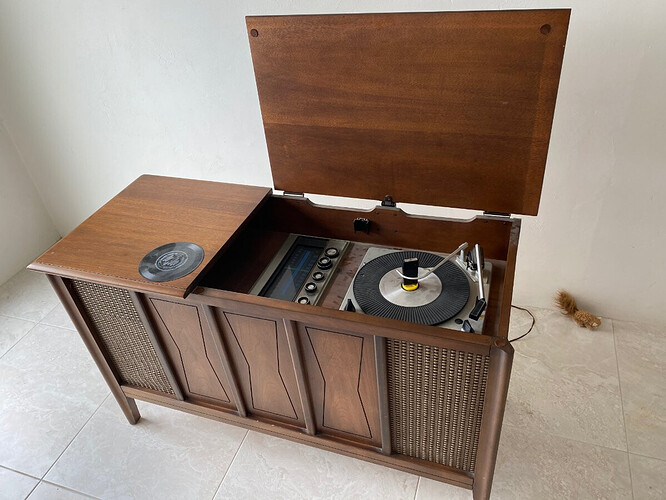Hi All,
I have a vintage (60’s maybe?) hi-fi system very similar to the image below that I’ve had an unresolved issue with. It’s just sitting in my house holding a lamp and I’m thinking about it now along with my unused vinyl.
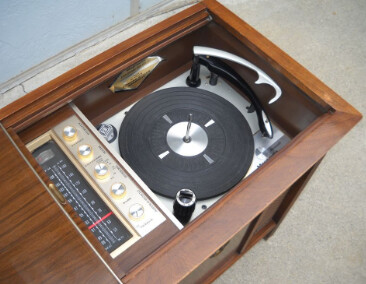
It was working fine some years ago, however one day it made a popping sound and proceeded to hum gradually louder until it sounded like it was going to blow completely. Now ever since, when you turn it on the hum starts quietly, but then quickly raises up to the level that sounds as if it will blow. I am admittedly not very good with audio equipment/circuitry on a technical level so I had a thought to see if someone here might have some sort of diagnosis based on the given information. I would guess there’s some sort of feedback loop or overpowering of the circuit somehow, but these are just guesses I’ve come up with based on my non-knowledge on the subject haha.
The components are original and thus very old. I don’t know exactly how far I’ll go with attempting a full repair tbh, but if it’s a loose connection I can solder pretty easily I’m certainly game. Mostly just want the sound to work again. The turntable and radio were working pre incident. Half open to the idea of modernizing the internals and speakers. Just may be in over my head to take on a new project. (Just had a baby)
I’m far from an expert so if @Bunker were to contest this I would default to his opinion, but the pop along with the age of the unit and the gradual build up of the noise leads me in the direction of a large capacitor, probably in the power circuit but the thing likely doesn’t have an isolated power circuit so it’s bleeding into the audio. It’s apparently not fully dead but it’s damaged, as it slowly charges up (like a battery lets say) the issue becomes more and more present.
A slightly more “backed up with facts” version of this is in the description of how capacitors are used in AC circuits a la google:
" Electrical engineers use capacitors to improve the power factor in an AC circuit . For example, an AC circuit powering inductive loads like a motor results in a lagging current. Adding a capacitor helps compensate for the lagging current and brings the power factor closer to unity."
So as I say, I don’t know much but that’s my uneducated guess. Good luck, those things are cool and so heavy they’re a pain to get rid of!
I would be VERY careful testing a unit of this age, even with a good multimeter. When visually inspecting for a large electrolytic capacitor that has gone bad you may be able to tell just by the appearance of it’s crown, but the capacitors in this guy may appear more like these which will possibly make it more difficult if it’s half working. Will probably require a meter and some thorough note taking…
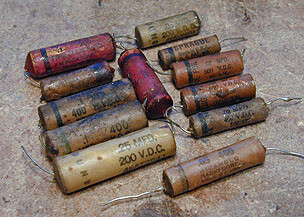
4 Likes
Thank you very much for the insight. This is definitely a step in the right direction I’d say. Hopefully it’s easy enough to spot, but even then would it be difficult to replace/source such old components?
1 Like
I would be very cautious of lead fumes from desoldering old school components. Aside from that hard to tell, depends on where you are and who made the console. Might be expensive, might be cheap. Could be unobtainable. Could be delicate, you’ll have to eyeball the situation as there are infinite variables that can come into play. Without putting eyes on it, everything is going to be hypothetical.
If someone says “that horse was so fast it was flying” and you imagine that it has wings, then you try to figure out how it was so fast with the assumption it was literally flying, when you come face to face with a wingless creature all your hypothesis goes out the window. I say crack it open, carefully, and assess the situation.
I think it can’t get any worse, that’s for sure. Could also be related to a transformer if the coil is damaged but I have a feeling it would have a little different symptom so I just can’t say as I’m not an expert.
If you have or can find the model number try and get a schematic for it off google first.
1 Like
Just to clarify, how old is it? it’s not a tube console is it? I’m assuming it’s solid state as it appears more of a 60’s / 70’s design motif but I could be totally wrong on that - just there weren’t a lot of orange bakelite radio indicator needles or aluminum knobs in the 40’s/50’s…
nevermind I see you said 60’s maybe so you don’t know the precise vintage - start with identifying the model, look at pictures if theres more than one iteration of the same model and determine the vintage. Then you’ll know if it’s solid state or tube, tube will be riskier to mess with.
1 Like
I haven’t the slightest at the moment. Will have a closer look when I get home and hopefully get an answer. Perhaps with pics!
1 Like
Pft, wahatevr dude. i grue up smokin led and i ternd out just fine.
2 Likes
lol out of a wood pipe perhaps?
of course not, a lead pipe. clearly.
4 Likes
Might be easier to just take a look. If it’s tubes there’s a good chance of being some ventilation slots somewhere and you’ll see the glow of tubes. If that fails, removing an access panel (back or underneath maybe) should let you see the tube glow or lack of.
Totally unscientific guess: it has more of a transitory era vibe to it.
1 Like
I would normally agree with you but even moving the thing in one place with one person is a chore, I had one and it weighed about a billion pounds and nothing was made to be easily accessed. But you’re correct in that it might have a vent somewhere. Either way, it will be difficult to identify old parts without knowing what model it is, unless it’s written super clearly on the part in question, knowing what it is can lead to information about parts that commonly fail in the design. Old part numbers are sometimes dead ends too.
1 Like
Ok so its not heavy and is a Montgomery Ward model i havent been able to identify online. Also fairly certain it’s tube based.
2 Likes
gimme a minute to dig. this must be pretty old. I don’t see anything solid state in there.
Mine was long, like the length of a chest of drawers, how big is the cabinet in width
look at this video and tell me how similar in form it is to this one
actually I can see it’s at the end of a larger console, it’s not as freestanding as this one now that I look.
is it closer to this one?
well I’m gonna look for a few more minutes but I can already tell you 2 things, I think you’re going to need a professional to troubleshoot it and that plus the cost of repair is going to cost you more than buying a record player. If you love the thing, I’d invest in it otherwise the cost will exceed the benefit.
I’m still searching though, there’s a lot of these montgomery ward airline radio / record player consoles but nothing so far that matches the part number wg-2375A
Alright so while I’m finding zero on the specific model, here is a troubleshooting for hum in a vintage tube console radio/turntable video and in general, this might help give you an idea of whether or not you feel like you can get into it on your own
1 Like
Definitely looks more like the second image. Thanks for the advice. I think I had come to the conclusion it was likely more trouble than it’s worth before, but thought maybe to poke the idea once more with some Elektronaut help. I’m not tied to the unit per se and should probably get rid of it other than the fact it’s a decent tabletop for stuff in my house at this point. I will check out the hum video and let you know if anything clicks for me.
Since it’s a tube unit it probably sounds great when it works, I hope that it’s something simple since visually the insides look good. If it’s one tube like the rectifier tube that needs to be replaced it wouldn’t be crazy bad pricewise, just to determine which tube is bad could be a pain. For reference, my guitar amp has less total tubes than this hifi unit and when I was pricing a new set of tubes within the last year (because the last time I put new tubes in it was like 25 years ago), my options ranged from 120-250 for a full set. That doesn’t mean you need a full set of tubes, just illustrating that it could be a couple hundred bucks easily if the “fix” is to throw a new set of tubes at it and hope that fixes the issue without detailed diagnosis.
Given the nature of the issue, I still would not write off a capacitor as potentially being the culprit but with the nature of tube amps, I would not be surpised if one or more tubes were toast. Hopefully that video or something else will help gel things for you. Wish I had a more precise compass on this but good luck either way and keep this updated if you find anything out.
1 Like
It’s really hard to say without seeing it in person but smart money would be on the input power’s electrolytic capacitor. They do tend to go bad and what you’re describing is a common enough symptom of that part failing. Keep in mind capacitors can store and hold a charge, potentially for a long time, even when the unit is powered off and unplugged. Use caution when working with them, especially with tube equipment as you’ll be dealing with higher voltages than most modern devices. It can be done safely, just read up on discharging.
There are other things that could potentially cause a hum like that like a bad tube (rectifier would be most likely tube but could be others), input or output transformers (not super likely), some kind of grounding issue, a different capacitor, etc… but my best guess without seeing it would be that capacitor.
3 Likes
If you figure anything out about your noise issue in the next few days, one of the places where I buy parts from time to time and who likes to harass me with special offers just sent an email about a capacitor sale.

They also usually have some reasonably priced options on tubes so I’m not saying throw money at the thing without a goal or clear objective, but if you diagnose a bad capacitor or you want to price a rectifier tube, you could first identify what’s inside (if there’s either a schematic sticker or by seeing which of the larger tubes gets a hit on google as being a rectifier) usually power tubes or preamp tubes only use specific varieties, so a rectifier tube will only identify as a rectifier and usually the tube code is printed on the glass part of the tube itself.
Just saw this and thought I’d mention.
1 Like
Very much appreciate this. I should have some time this weekend to dig in and see what I can identify.

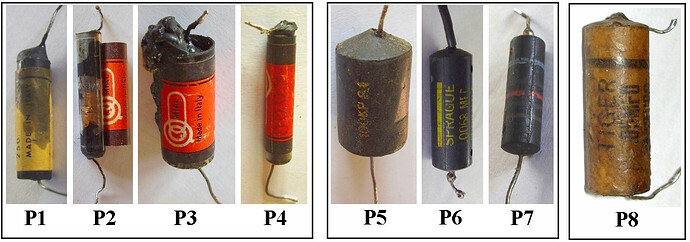



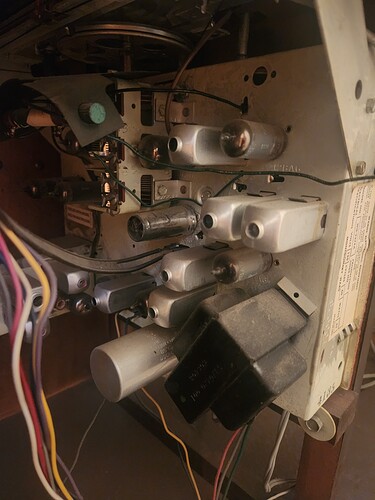
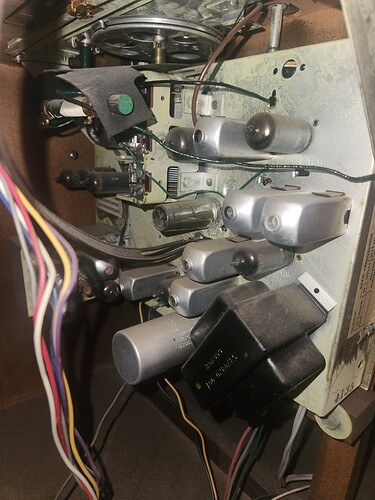
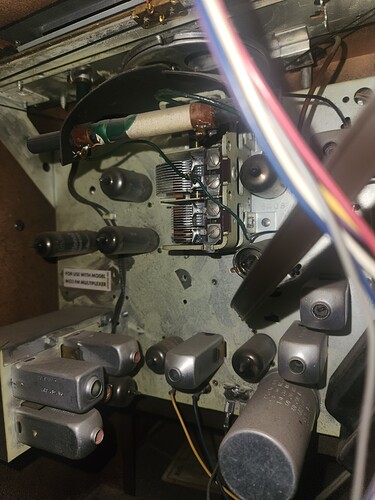
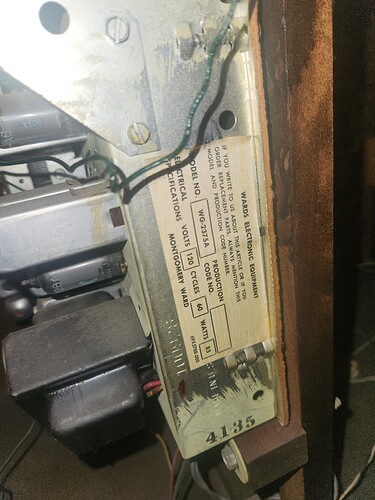
![1956 Montgomery Ward Airline Radio & Record Changer [PART 1]](https://img.youtube.com/vi/3gymius5uT0/maxresdefault.jpg)
